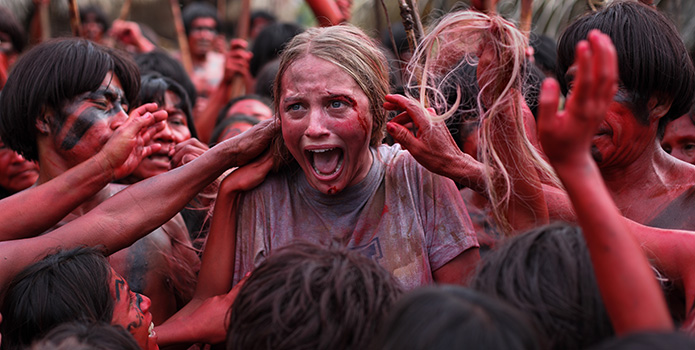 The Green Inferno
The Green Inferno
Written by Guillermo Amoedo, Eli Roth, and Nicholas Lopez
Directed by Eli Roth
USA, 2013
The notoriously lurid and savage films of the 1970s evidently served as Eli Roth’s primary inspiration for his latest playful excavation into the squealing recess of the human body, the elder of which is the infamous Cannibal Holocaust, whose naïve-innocents-abroad plot has been seized and given a contemporary twist here, although the title has been speared from an alternate moniker of 1988’s Natura Contro. This film’s putrid predecessor, Cannibal Holocaust, is one of the few films of the era to have a genuine and cruel edge to its proceedings, a real vibe that you’re risking your mental and spiritual health by viewing such distressing material, mostly due to the real animal cruelty, which has led the film to be quite rightly consigned to the dustbins of history. Thus, just how Roth managed to make a film that is so tediously sterile and shrug-inducingly indifferent, considering the ravenous subject matter, remains a mystery as dense as the deadly Peruvian jungle.
Appealing to the Occupy generation, The Green Inferno begins in New York City, as politically attuned and feminist minded student Justine (Lorenza Izzo) is slowly drawn into a radical student group planning a direct action protest of a developer’s incursion into a native tribe’s protected reservation in the Peruvian jungle. Slightly smitten with the group’s charismatic leader, Justine agrees to accompany the group on their activist adventure; after alighting in the continent, the radicals successfully execute their globally streamed, web-savvy enterprise. Smug and slightly giddy at their success, the group’s fortunes quickly change when their single prop plane crash-lands deep in the emerald canopy. Soon, the innocents get an up-close and personal taste of the people who they purportedly claim to defend. These natives are hungry to make new friends.

There is a certainly a film to be made about the interfering influence of idealistic adolescents into other supposedly inferior countries and cultures. However, Roth, a director with all the subtlety and charm of a rusty entrail-smeared machete is not the person to make that film. It’s hard to believe that Roth could make an uninvolving dish from such ripe and bloody genre ingredients, but The Green Inferno is lukewarm gory gruel at best, with no Michelin massacre stars in attendance. For the gorehound gourmets, the presence of Greg Nicotero on prosthetics and dismemberment duties may draw them out from the canopy, but Roth seems to lack even his usual twisted imagination; one early deconstruction aside, the set-piece kills are perfunctory and predictable. The opening story-setting scenes are fatty and could easily benefit from a ten-minute trim. From another technical standpoint, the general editing is, yes, roughly hewn and choppy in places, especially around some key murder moments and plot pirouettes.

Maybe, with The Green Inferno, Roth was attempting to emulate some of the amateurish filmmaking patterns of the original breed of films, but if he intended them as homage, the purpose really isn’t clear. There is an unfortunate subtext to Roth’s work, which one wonders is subconsciously considered: he always populates his films with naive idiots who fall afoul of psychopathic foreigners, except perhaps for Cabin Fever. Even the films he produces cannot shake off the shackles of this distasteful insular pseudo-racism, as any recent digestion of the Aftershock atrocity will attest. If he’s going to continue his career in the notoriously unforgiving industry with its specifically ghoulish spittle-flecked fans, then Roth needs some new blood in both his movies’ ideas and executions.
– John McEntee
–
Editor’s Note: This review was originally published in 2013 for the Toronto International Film Festival.





